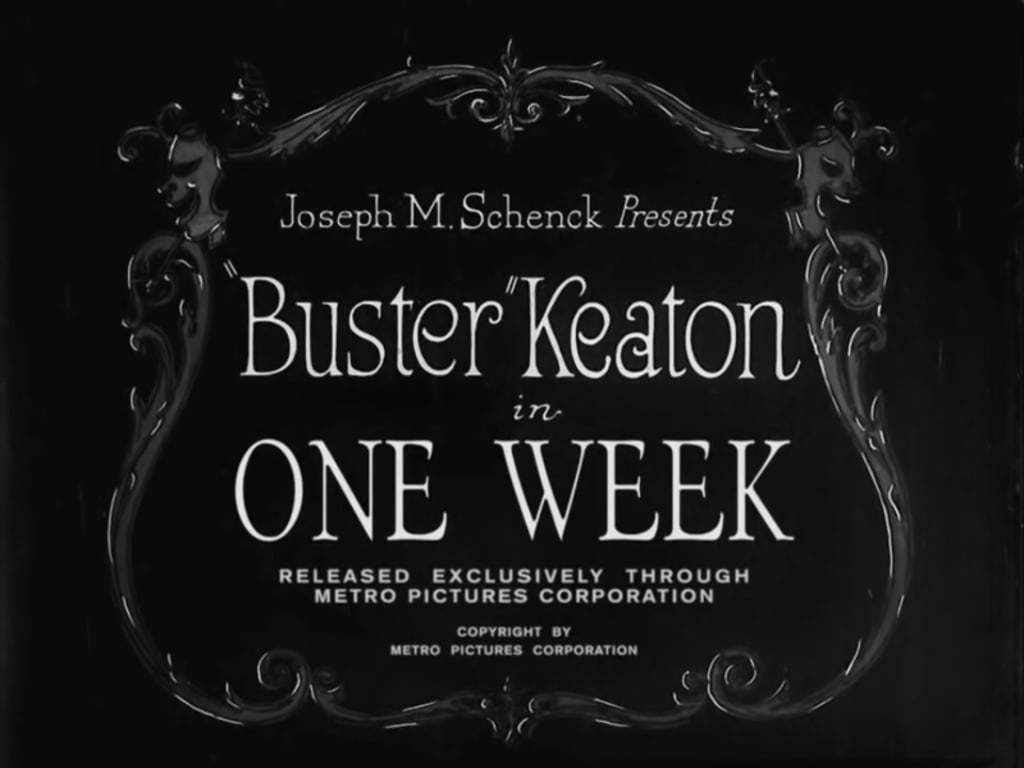
That little bastard Buster is at it again, getting hitched up to a sweet young girl, riding like a loon between two cars, his legs spread out beneath him, just enough room for that motorcyclist to come careening along, and, hopefully, ride between his legs (stop laughing, damn you!). But Buster gets creamed anyway.
He kicks the legs out from under some suspiciously Chaplinesque Keystone Cop for obscure reasons. His wedding car has a sign (besides the requisite "Just Married" scrawled on a sign on the side of it) that says, "Good luck. They'll need it!" And how!
Buster and the blushing bride have a lot donated by a rich uncle, lot 99. Keep that in mind. And they have an "Insta-House" housebuilding house-in-a-box kit that has numbered instructions that some dastard, a jealous guy, hank, who's two feet taller, seemingly, than Buster, who paints new numbers, altering the old, as a practical joke, to confuse the HELL out of poor Buster, who builds a house straight out of Caligari's expressionist nightmare, all dream-like weird angles and face-like facade that is windows leaning crazily and a roof like a hat.
So Buster begins to build. And he pulls the chandelier and ceiling into a tent-like point. And sends Hank's head busting through the roof. And he falls off of ladders and walks out of doors leading to a drop into the dirt yard outside. His lovely little bride takes a high-rise ride on the side of the house, but, even after it's finished (well, most especially after it's finished), it's still the leaning-crazily at Lovecraftian angles nightmare message from the dream-time that is the movie: GET OUT! No demonic voice needs to tell them. In a dream, which is all a movie is, except wide-awake, a house that is unsafe, uncompleted, still being constructed, or whose walls, floor, and ceiling all lean at crazy angles. This means the Dreamer (Buster, or the Viewer) is himself (non-generative) incomplete; that he or she is working on something internal that is unfixed or unfinished; that their internal landscape is suffused with broken angles found only in the horrific dreams of a mind tortured by self-doubt, anxiety, or melancholy and fear over that WHICH IS TO BE.
So the house stands as a comic-grotesque, foreboding symbol of their fractured dreams, fallen apart. There must be something lurking in the bosom of their so-recent, happy marriage. Buster can't build their dream house, because the "numbers are all wrong." A pointed comment, it is, on the Law of Averages. In the end, luck and fidelity, and happiness is "all a numbers game," and here, numbers are very significant, the dates on the calendar rolling around unluckily to Friday the Thirteenth.
But it is Saturday the 14th wherein, the whole family (and bitter Hank, the Saboteur) gather for a "housewarming dinner," and Buster manages to kick the chair out from the lumbering Hank, who chases through the kitchen and out a door that opens into nothing, where he runs across the air and straight into a fence.
A gale-force hurricane wind roars up, and Buster proceeds through his damaged house holding an umbrella, and if you caught individual images of this in a literal DREAM, you'd think it was the craziest thing you'd ever seen--the most illogical, the most surreal. In other words, slapstick is a form of surrealism, I swear; how any of the early surrealists were influenced by Duck Soup and the Marx Brothers? (Maybe not technically the same thing, but there it is.) Comic dream images dredged up, visual non-sequiturs, and absurdist actions and reactions. The world of slapstick is one of the subconscious Freudian impulses. There IS a deeper meaning here.
Little honey, for instance, is seen taking a bath. Beautiful. She conveniently drops the soap, and a convenient, omnipotent hand covers the lens, so we don't see her nudeness as she bends out of the tub to retrieve it. She has a coy, playful look on her face right before she reaches out of the tub, revealing her nudity, to retrieve the errant bar of Ivory. She's been cleaning herself; she doesn't want to be "dirty" again, by feeding the viewer's fantasies. An omnipotent hand of conscious guilt covers our eyes as if we were children.
Later, hubby Buster, who has been putting a chimney in place (or trying to) falls down the ladder, comes crashing through the ceiling, splashing into the tub, with his wife curled in a shower curtain, pointing at him angrily, her screaming lips moving silently of course, but, we can well imagine just what she is saying.
The housewarming party turns into a house-twisting, house-soaking riotous bad time, as a storm sends the dilapidated domicile spinning, and Buster, with incredible agility, runs round and round it, over the porch and down it and up again, and is almost blown away by the wind. Inside, the guests flail around in a terrified circle around the dining room, the walls spinning, their arms held up in terror. The house is a living instrument of terror and frustration; one is reminded of the strange scenes in Un Chien Andalou wherein two protagonists pull, via rope, what look to be sections of the wall or cement or plaster, and behind them, a dead cow, and a rabbi at a piano, if I remember correctly. You could interpret this in any manner you want, but perhaps it is the frustrations of a dreaming mind rebelling against the confined space of bourgeois values.
Finally, after a night of whirlwind, the couple, who have slept all night in the rain, awaken to find that their dream home-in-a-kit is placed on THE WRONG LOT. Not lot 66, they need to be at, but LOT 99. They attempt to move the whole rotten structure, nailing it to a car and rolling it on barrels. A train is coming. It narrowly misses them.
To give away the ending is perverse, but they walk off together, leaving their dreams in their wake. As long as they've got each other I suppose, they can walk off into a Hollywood sunset of yesteryear, and leave the nightmare domicile behind, with all the agony of expectation and broken dreams they swept their bittersweet selves into.
One week is comic brilliance; timeless, slapstick humor, with an undertone of the nearly surreal. It is one of Buster Keaton's defining moments, and, as such, will not leave the viewer disappointed.
Buster Keaton in ONE WEEK (1920)
About the Creator
Tom Baker
Author of Haunted Indianapolis, Indiana Ghost Folklore, Midwest Maniacs, Midwest UFOs and Beyond, Scary Urban Legends, 50 Famous Fables and Folk Tales, and Notorious Crimes of the Upper Midwest.: http://tombakerbooks.weebly.com






Comments
There are no comments for this story
Be the first to respond and start the conversation.